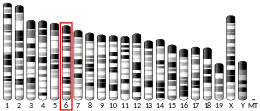Guanylate cyclase 2C
Guanylate cyclase 2C, also known as guanylyl cyclase C (GC-C), intestinal guanylate cyclase, guanylate cyclase-C receptor, or the heat-stable enterotoxin receptor (hSTAR) is an enzyme that in humans is encoded by the GUCY2C gene.[5][6]
Guanylyl cyclase is an enzyme found in the luminal aspect of intestinal epithelium and dopamine neurons in the brain.[7] The receptor has an extracellular ligand-binding domain, a single transmembrane region, a region with sequence similar to that of protein kinases, and a C-terminal guanylate cyclase domain. Tyrosine kinase activity mediates the GC-C signaling pathway within the cell.
Functions
GC-C is a key receptor for heat-stable enterotoxins that are responsible for acute secretory diarrhea.[8] Heat-stable enterotoxins are produced by pathogens such as Escherichia coli. Knockout mice deficient in the GC-C gene do not show secretory diarrhea on infection with E. coli, though they do with cholera toxin. This demonstrates the specificity of the GC-C receptor.
In medicine
Guanylate cyclase 2C is the target of linaclotide, an oligopeptide agonist used for the treatment of chronic constipation.
References
- 1 2 3 GRCh38: Ensembl release 89: ENSG00000070019 - Ensembl, May 2017
- 1 2 3 GRCm38: Ensembl release 89: ENSMUSG00000042638 - Ensembl, May 2017
- ↑ "Human PubMed Reference:". National Center for Biotechnology Information, U.S. National Library of Medicine.
- ↑ "Mouse PubMed Reference:". National Center for Biotechnology Information, U.S. National Library of Medicine.
- ↑ "Entrez Gene: guanylate cyclase 2C (heat stable enterotoxin receptor)".
- ↑ Mann EA, Swenson ES, Copeland NG, Gilbert DJ, Jenkins NA, Taguchi T, Testa JR, Giannella RA (June 1996). "Localization of the guanylyl cyclase C gene to mouse chromosome 6 and human chromosome 12p12". Genomics. 34 (2): 265–7. doi:10.1006/geno.1996.0284. PMID 8661067.
- ↑ Intestinal Protein May Have Role in ADHD, Other Neurological Disorders. ScienceDaily (Aug. 11, 2011)
- ↑ Weiglmeier PR, Rösch P, Berkner H (August 2010). "Cure and Curse: E. coli Heat-Stable Enterotoxin and Its Receptor Guanylyl Cyclase C". Toxins. 2 (9): 2213–2229. doi:10.3390/toxins2092213. PMC 3153297. PMID 22069681.
Further reading
- Schulz S, Hyslop T, Haaf J, et al. (2006). "A validated quantitative assay to detect occult micrometastases by reverse transcriptase-polymerase chain reaction of guanylyl cyclase C in patients with colorectal cancer". Clin. Cancer Res. 12 (15): 4545–52. doi:10.1158/1078-0432.CCR-06-0865. PMID 16899600.
- Park J, Schulz S, Haaf J, et al. (2002). "Ectopic expression of guanylyl cyclase C in adenocarcinomas of the esophagus and stomach". Cancer Epidemiol. Biomarkers Prev. 11 (8): 739–44. PMID 12163327.
- Tien YW, Lee PH, Hu RH, et al. (2003). "The role of gelatinase in hepatic metastasis of colorectal cancer". Clin. Cancer Res. 9 (13): 4891–6. PMID 14581363.
- Basu N, Bhandari R, Natarajan VT, Visweswariah SS (2009). "Cross talk between receptor guanylyl cyclase C and c-src tyrosine kinase regulates colon cancer cell cytostasis". Mol. Cell. Biol. 29 (19): 5277–89. doi:10.1128/MCB.00001-09. PMC 2747985. PMID 19620276.
- Mann EA, Steinbrecher KA, Stroup C, et al. (2005). "Lack of guanylyl cyclase C, the receptor for Escherichia coli heat-stable enterotoxin, results in reduced polyp formation and increased apoptosis in the multiple intestinal neoplasia (Min) mouse model". Int. J. Cancer. 116 (4): 500–5. doi:10.1002/ijc.21119. PMID 15825168. S2CID 28833622.
- Saha S, Biswas KH, Kondapalli C, et al. (2009). "The linker region in receptor guanylyl cyclases is a key regulatory module: mutational analysis of guanylyl cyclase C." J. Biol. Chem. 284 (40): 27135–45. doi:10.1074/jbc.M109.020032. PMC 2786029. PMID 19648115.
- Bhandari R, Srinivasan N, Mahaboobi M, et al. (2001). "Functional inactivation of the human guanylyl cyclase C receptor: modeling and mutation of the protein kinase-like domain". Biochemistry. 40 (31): 9196–206. doi:10.1021/bi002595g. PMID 11478887.
- Sindiće A, Başoglu C, Cerçi A, et al. (2002). "Guanylin, uroguanylin, and heat-stable euterotoxin activate guanylate cyclase C and/or a pertussis toxin-sensitive G protein in human proximal tubule cells". J. Biol. Chem. 277 (20): 17758–64. doi:10.1074/jbc.M110627200. PMID 11889121.
- Jaleel M, London RM, Eber SL, et al. (2002). "Expression of the receptor guanylyl cyclase C and its ligands in reproductive tissues of the rat: a potential role for a novel signaling pathway in the epididymis". Biol. Reprod. 67 (6): 1975–80. doi:10.1095/biolreprod.102.006445. PMID 12444076.
- Mejia A, Schulz S, Hyslop T, et al. (2009). "GUCY2C reverse transcriptase PCR to stage pN0 colorectal cancer patients". Expert Rev. Mol. Diagn. 9 (8): 777–85. doi:10.1586/erm.09.67. PMC 2810399. PMID 19895223.
- Scott RO, Thelin WR, Milgram SL (2002). "A novel PDZ protein regulates the activity of guanylyl cyclase C, the heat-stable enterotoxin receptor". J. Biol. Chem. 277 (25): 22934–41. doi:10.1074/jbc.M202434200. PMID 11950846.
- Ghanekar Y, Chandrashaker A, Tatu U, Visweswariah SS (2004). "Glycosylation of the receptor guanylate cyclase C: role in ligand binding and catalytic activity". Biochem. J. 379 (Pt 3): 653–63. doi:10.1042/BJ20040001. PMC 1224121. PMID 14748740.
- Kulaksiz H, Cetin Y (2001). "Uroguanylin and guanylate cyclase C in the human pancreas: expression and mutuality of ligand/receptor localization as indicators of intercellular paracrine signaling pathways". J. Endocrinol. 170 (1): 267–75. doi:10.1677/joe.0.1700267. PMID 11431160.
- Debruyne PR, Witek M, Gong L, et al. (2006). "Bile acids induce ectopic expression of intestinal guanylyl cyclase C Through nuclear factor-kappaB and Cdx2 in human esophageal cells". Gastroenterology. 130 (4): 1191–206. doi:10.1053/j.gastro.2005.12.032. PMID 16618413.
- Singh R (2003). "Interaction of guanylyl cyclase C with SH3 domain of Src tyrosine kinase. Yet another mechanism for desensitization". J. Biol. Chem. 278 (27): 24342–9. doi:10.1074/jbc.M301153200. PMID 12649275.
- Selvaraj NG, Prasad R, Goldstein JL, Rao MC (2000). "Evidence for the presence of cGMP-dependent protein kinase-II in human distal colon and in T84, the colonic cell line". Biochim. Biophys. Acta. 1498 (1): 32–43. doi:10.1016/s0167-4889(00)00075-6. PMID 11042348.
- Ciocca V, Bombonati A, Palazzo JP, et al. (2009). "Guanylyl cyclase C is a specific marker for differentiating primary and metastatic ovarian mucinous neoplasms". Histopathology. 55 (2): 182–8. doi:10.1111/j.1365-2559.2009.03358.x. PMC 3140017. PMID 19694825.
- Strausberg RL, Feingold EA, Grouse LH, et al. (2002). "Generation and initial analysis of more than 15,000 full-length human and mouse cDNA sequences". Proc. Natl. Acad. Sci. U.S.A. 99 (26): 16899–903. Bibcode:2002PNAS...9916899M. doi:10.1073/pnas.242603899. PMC 139241. PMID 12477932.
- Dias Neto E, Correa RG, Verjovski-Almeida S, et al. (2000). "Shotgun sequencing of the human transcriptome with ORF expressed sequence tags". Proc. Natl. Acad. Sci. U.S.A. 97 (7): 3491–6. Bibcode:2000PNAS...97.3491D. doi:10.1073/pnas.97.7.3491. PMC 16267. PMID 10737800.
External links
- GCC testing for colorectal cancer staging
- GC-C knock-out mice
- guanyl+cyclase-C+receptor at the US National Library of Medicine Medical Subject Headings (MeSH)



